p.137
p.141
p.146
p.153
p.158
p.162
p.171
p.180
p.187
Vacuum-Free Continuous Fabrication for Forming Narrow Bus Wires
Abstract:
Photolithography is undoubtedly the most widely used patterning method for the fabrication of micro-and nanofeatures, despite the recent development in some unconventional fabrication techniques that are poised to take over certain applications. But photolithography is still the main fabrication method in industry. To step forward in many applied areas, however, large-area, continuous fabrication system needs to be developed. However photolithography has not been extended to large area continuous patterning like other printing technologies. Photolithography is currently based on wafer scale fabrication and metal deposition process is performed under high vacuum condition. Here we report the development of continuous roll type contact photolithography which is termed photo roll lithography (PRL) and vacuum-free metal filling method. Continuous patterning is achieved was by employing a flexible photomask with Al patterns, which was fabricated by conventional photolithography method. Also, metal nanopowder was stuffed in fabricated PR patterns by puffs, instead of conventional deposition methods. As a feasible application, we demonstrated a fabrication of narrow bus wire for using on display devices.
Info:
Periodical:
Pages:
158-161
Citation:
Online since:
December 2013
Keywords:
Price:
Сopyright:
© 2014 Trans Tech Publications Ltd. All Rights Reserved
Share:
Citation:


